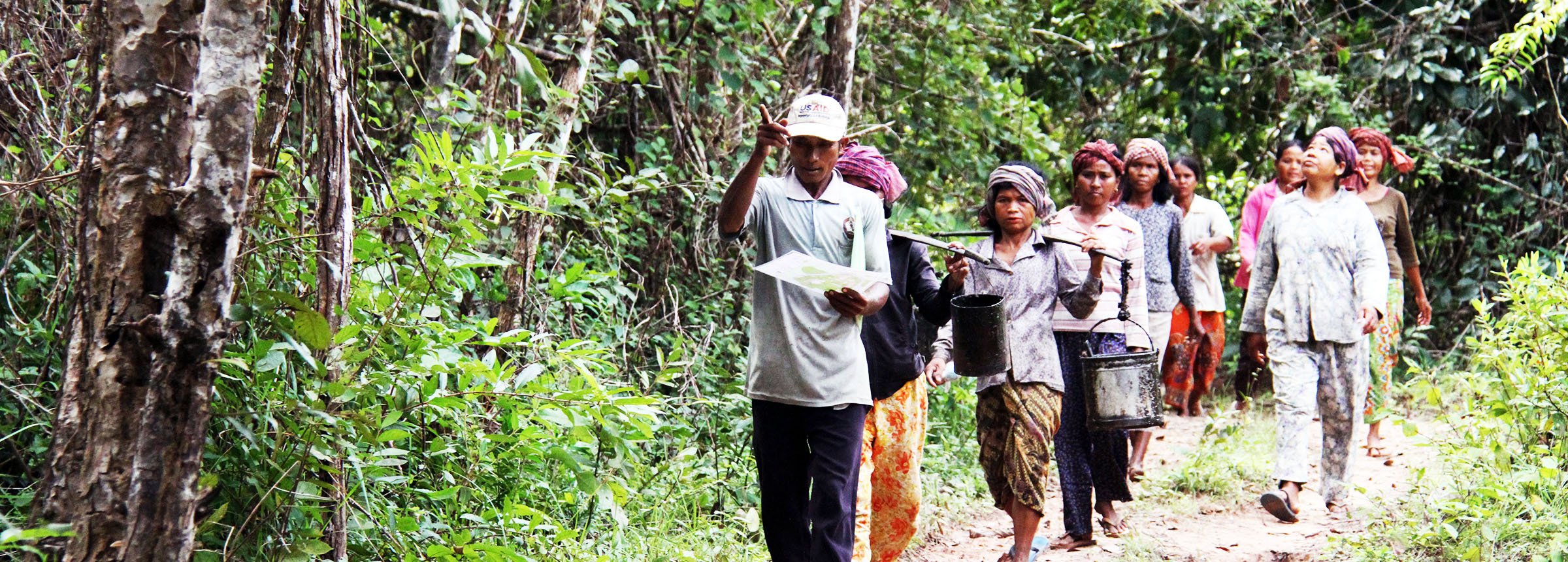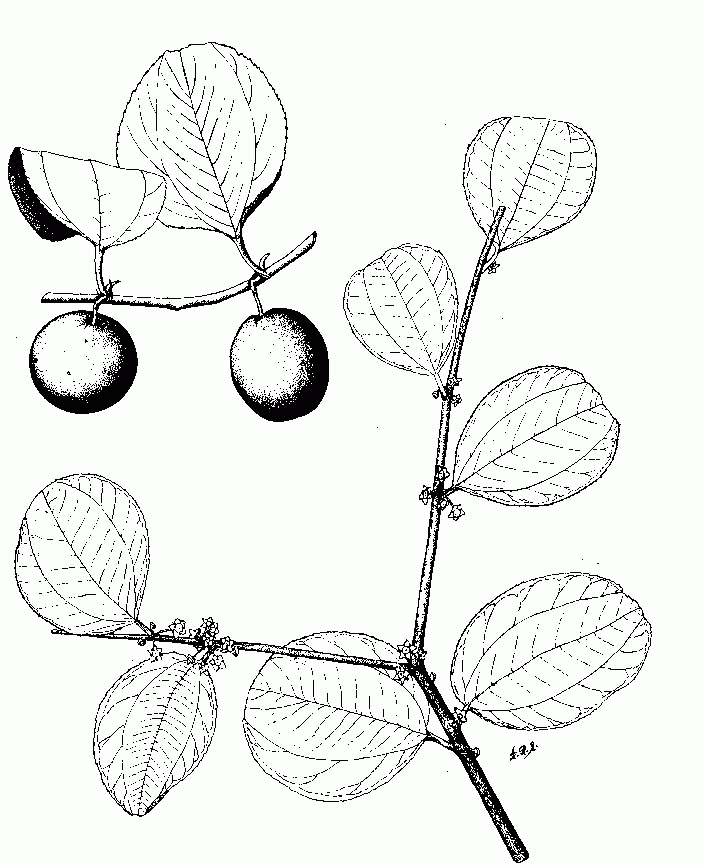
Ziziphus mauritiana – a valuable tree for arid and semi-arid lands
FACT 98-03, June 1998
A quick guide to multipurpose trees from around the world
The use of Ziziphus mauritiana in India can be traced back to as early as 1,000 BC. This species which is also known as ber, Indian jujube, Indian plum, or desert apple, is an ever-green, medium-sized, thorny tree, whose greatest quality is its ability to thrive and produce fruits in arid or semi-arid regions.
One idealist describes this species as “a gift of mother nature which symbolizes the productive capacity of the seemingly infertile ecosystem”. An apt description of its value is that ber produces the three vital “f’s” that desert dwellers require—fruit, fodder, and fuel (Vashishtha 1997).
Ber belongs to the Rhamnaceae family. Of the well-known species of the genus Ziziphus, ber (Z. mauritiana) is the most common in the tropical and sub-tropical regions, while Z. jujuba is well known in temperate parts of the world. Extensive research on ber was first undertaken in India. Research on this species has expanded to Israel, Malawi, Senegal, and Zimbabwe.
 Botany
Botany
Ber is a medium sized tree that grows vigorously and has a rapidly developing taproot, a necessary adaptation to drought conditions. The species varies widely in height, from a shrub 1.5 to 2 m tall, to a tree 10 to 12 m tall with a trunk diameter of about 30 cm. Ber tree may be erect or wide-spreading, with gracefully drooping thorny branches.
The leaves are alternate, ovate or oblong elliptic, with 3 veins at the base, and are usually about 2.5 to 3.2 cm long and 1.8 to 3.8 cm wide. The flowers are yellow, 5-petalled and are usually in twos and threes in the leaf axils. This quick growing tree starts producing fruits within three years. It will not set fruit by self-pollination. Fruits vary in shape and size. They can be round, oval or oblong; large, medium or small. Most are round to oval. Size can be as small as 1.8 to 2.5 cm for fruit from wild trees or as large as 5 cm (plum sized) from improved cultivars. Ber fruits are first green, turning yellow as they ripen. The ripe fruit is sweet and sour in taste. Both flesh texture and taste are reminiscent of apples.
Ecology
Commercial cultivation of ber usually extends up to 1,000 m. Beyond this elevation trees do not perform well and cultivation becomes less economical. This species is able to survive temperatures as high as 50°C. In India trees survive minimum shade temperatures of 7° to 13° C. However, this hardy fruit tree does not tolerate frost well. Native to the tropical and sub-tropical regions, ber can grow where annual rainfall ranges from 125 to 2,225 mm, but is more widespread in areas with an annual rainfall of 300 to 500 mm. It is known for its ability to withstand adverse conditions, such as salinity, drought and waterlogging. Studies report that this species flourishes in alkaline soils with a pH as high as 9.2. However, deep sandy loam to loamy soils with neutral or slightly alkaline pH are considered optimum for growth.
Distribution
Early studies indicate that the center of origin of ber is Central Asia. This species is indigenous to north Africa; from Afghanistan through north India to southern China; Malaysia; and Queensland in Australia. However, ber is now widely distributed and has become naturalized in tropical Africa, Iran, Syria, Sri Lanka, Burma, Barbados, Jamaica, Guadeloupe and Martinique, and parts of the Mediterranean.
Uses
Fruits. Ber fruits are very nutritious and are usually eaten fresh. Relatively unknown, this fruit is a rich source of vitamin C. It is second only to guava and much higher than citrus or apples. It contains 20 to 30% sugar, up to 2.5% protein and 12.8% carbohydrates. Fruits are also eaten in other forms, such as dried, candied, pickled, as juice, or as ber butter. In Malawi, dried fruit is used to make a potent distilled alcoholic beverage. Yields of 80 to 130 kg/tree/year have been reported in Africa (von Maydell 1986).
Fodder. In parts of India and north Africa, the leaves of ber are used as nutritious fodder for sheep and goats. Analysis of the chemicals constituents on a dry weight basis indicate the leaves contain 15.4% crude protein, 15.8% crude fiber, 6.7% total minerals, and 16.8% starch. In India, the leaves are also gathered as food for silkworms (Gupta 1993).
Wood. Ber timber is hard—with a specific gravity of 0.93— strong, fine-grained and reddish in color. It is most often used to make agricultural implements. The branches are used as framework in house construction. Ber makes good charcoal with a heat content of almost 4,900 kcal per kg. In addition, this species is used as firewood in many areas.
Other uses. This thorny tree makes good live fencing and is an excellent agroforestry tree to use in hedges. In India, ber trees are a host for the lac insects Kerria lacca, which are found on the leaves and makes an orange-red resinous substance. The purified resin makes a shellac used to produce sealing wax and vanish. High quality ber shellac is used in fine lacquer work.
Silviculture
Natural reproduction is through seed, stump, root suckers and coppice. Many existing silvicultural practices were developed in India, where domestication work began as early as the 1950’s.
Propagation. Scientists in India have standardized propaga-tion techniques for ber establishment. Budding is the easiest method of vegetative propagation used for improved culti-vars. Different types of budding techniques have been utilized with ring-budding and shield-budding being the most successful. Wild varieties of ber are usually used as the root-stock. The most common being Z. rotundifolia in India and Z. spina-christi in Africa.
Seedlings to be used as rootstock can be raised from seed. Several studies indicate that germination can be improved by soaking seeds in sulfuric acid. Germination time can also be shortened to 7 days by carefully cracking the endocarp. Ber seedlings do not tolerate transplanting, therefore the best al-ternatives are to sow the seeds directly in the field or to use polythene tubes placed in the nursery bed. Seedlings are ready for budding in 3 to 4 months. In addition, seedlings from the wild cultivars can be converted into improved culti-vars by top-working and grafting. Nurseries are used for large scale seedling multiplication and graft production.
Spacing and fertilizer requirements. For orchard estab-lishment recommended spacing is 7 x 7 m or 8 x 8 m. The wider spacing is preferred in areas with high rainfall where canopy development is vigorous. Many studies in India recommend the application of both farmyard manure and com-mercial fertilizers to maximum production. In Africa, the recommended fertilizer application is 20 to 120 kg N, 100 to 120 kg P, and 20 to 50 kg K per hectare. Fruit production begins in the 4th year with full production in the 10th to 12th year (von Maydell 1986).
Training and pruning. It is essential to train ber trees during the first 2 to 3 years to build a strong frame. Otherwise, these trees have a tendency to grow horizontally and downwards. If untrained, trees develop into a spreading bushy form with long slender branches. Yearly pruning is also important be-cause fruits are produced on current season’s growth. Regular pruning induces sufficient new growth to produce a good fruit crop annually. Removing 25% of the growth is usually sufficient. Pruning should occur when plants are dormant.
Limitations
Pests and diseases. The most serious pest of ber are the fruit flies, Carpomyia vesuviana and C. incompleta, which attack the fruits at the “pea” stage. Susceptibility generally differs by cultivar. Control of the pests can be attained by regular spraying of insecticides. Powdery mildew is the most impor-tant disease and results in premature defoliation and fruit drop. The disease can be effectively controlled by using chemicals.
Principal references
Bal, J.S. and D.K. Uppal. 1992. Ber Varieties. Department of Horticulture, Punjab Agricultural University, Ludhiana. New Delhi.
FAO Forestry Paper. 1982. Fruit-bearing forest trees. Technical notes, Rome.
Gupta, R.K. 1993. Multipurpose trees for Agroforestry and Wasteland Utilization. Winrock – Oxford & IBH Series, Inter-national Science Publisher, New York. p. 519-522.
Jawanda, J.S. and J.S. Bal. 1978. The ber, highly paying and rich in value. Indian Horticulture: 23:19-21.
Jawanda, J.S. 1981. The Ber – A highly remunerative fruit crop. Farmer and Parliament: 16: 15-16.
Maydell, Hans-Jürgon von. 1986. Trees and shrubs for the Sahel, their characteristics and uses. Deutsche Gesellschaft für Tech-nische Zusammenarbeit (GTZ). Federal Republic of Germany. p. 400-402.
Morton, J.F. Fruits of Warm Climates. 1987. J.F. Morton. Mi-ami, Florida, p. 191-196.
Nerd, A. and Y. Mizrahi. 1993. Introduction and domestication of rare fruits and nuts for desert areas. p. 355-363. In: J.Janick and J.E. Simon (eds), Advances in new crops. Timber Press, Portland Oregon.
Pareek, O.P. and S. Sharma. 1991. Fruit trees for arid and semi-arid lands. Indian Farming: 41: 25-33.
Sharma, V.P. and V.N. Kore. 1986. Ber. p. 592-615. In: Bose, T.K. and S.K. Mitra, (eds), Fruits: Tropical and sub-Tropical. Department of Horticulture, Bidhan Chandra Krishi Viswavidyalaya, Calcutta.
Vashishtha, B.B. 1997. Ziziphus for drylands – a perennial crop solving perennial problems. Agroforestry Today: 9: 10-12.
This issue was prepared by Susan Kaaria, Univ. of Minnesota, Forest Resources Dept., 1530 Cleveland Ave. N., St Paul, MN 55108-1027 USA
A publication of the Forest, Farm, and Community Tree Network
